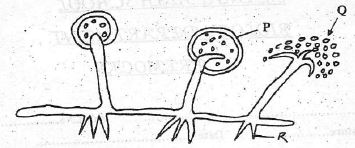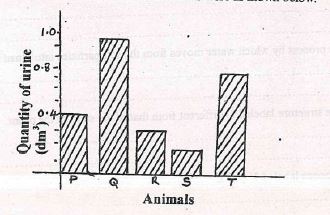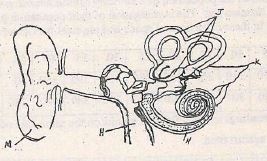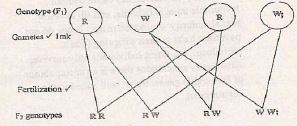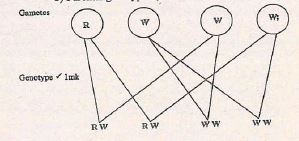BIOLOGY
PAPER 2
TIME: 2 HOURS.
Instructions to candidates
- This paper consists of two sections. Section A and section B.
- Answer ALL questions in section A in the spaces provided. In section B answer question 6 (compulsory) and either question 7 or 8 in the spaces provided after question
SECTION A: (40 MARKS) Answer all the questions in this section in the spaces provided
- The diagram below represents a mature bread mould (Rhizopus) (3mks)
- Name the structures P, Q and R(3mks)
P:
Q:
R: - What is the function of the structure P? (1mk)
- State two economic importances of moulds (2mks)
-
- Name the kingdom to which bread mould belong (1mk)
- List down one general characteristic of member of the kingdom named in d (i) above. (1mk)
- Name the structures P, Q and R(3mks)
- The diagram below represents a longitudinal section through a dicotyledonous root tip. (1 mk)
- State the function of the part labeled (1mk)
K
L
M - State the function of the part labeled N (1 mk)
- Name the process by which water moves from the soil particles into plant root (1mk)
- How is the structure labeled L different from that of the stem of the plant. (1 mk)
- Name the zones labeled Y and Z (2mks)
- State the function of the part labeled (1mk)
- Pure breed of red cows and pure breed of white bulls were crossed to give Fi calves which had a mixture of red and white coat known as roan. The Fı were selfed.
- Using letter R to represent gene for red colour and W to represent gene for white colour work out the phenotypic ratio of F2. (4mks)
- Work out the genotypic ratio of a cross between F offspring and white bull. (3mks)
- Comment on the gene(s) controlling the colour of coats in cattle mentioned above.(1mk)
- The quantities of urine passed out per day was established in five animals P, Q, R, S and T of the same species in their natural habitants. The results were as shown below.
-
- Which of the five animals was likely to be excreting urine very rich in ammonia. (1mk)
- Give a reason for your answer in (a) (i) above (1mk)
-
- Which of the animals was likely to be liveng in a desert environment (1 mk)
- Give a reason for your answer in (b) (i) above (1mk)
- Explain how ingestion of very salty fond may affect the quantity of urine produced (2mks)
-
- The diagram below represent a section through the maminalian ear. Study it and answer the questions that follow.
- Name the structures labeled H and J (2mks)
H
J - State how the structures labeled H, M and N are adapted to their functions (3mks)
H
M
N - State what would happen if the structure labeled K was completely damaged (1mk)
- Name the fluid contained in structure N (1 mk)
- Apart from hearing, state the other role performed by the human ear (1 mk)
- Name the structures labeled H and J (2mks)
SECTION B (40 MARKS)
Answer question 6 (compulsory) in the spaces provided and either question 7 or 8 in the spaces provided after question :.
- The table below shows the population of a housefly Muscadomistica which is parasitized by. wasps of species Nasonia spp. The investigation of their population growth pattern was carried out for 70 weeks. In these experimental space and physical factors were assumed not to be limiting.
Time in weeks 0 5 10 15 20 25 30 35 40 45 50 55 60 65 70 Muscadomestica 40 70 110 260 350 480 400 395 350 40 60 140 250 240 230 Nasoniaspp 10 20 30 45 100 200 300 380 410 250 60 20 40 200 280 - Using the readings in the table, plot graphs on the same axis of population growth of organisms against time. (8mks)
- Account for the growth of
- Muscadomestica between 10th week - 25th week (1mk)
- Nasonia species between 40th week - 50th week (1mk)
- What is the population of?
- NasoniaSpp on the 62nd week (1mk)
- Muscadomestica on the 4th week (1mk)
- Bemex, another parasite of housefly was introduced into the ecosystem. Giving a reason what will be the effect on the population of
- Housefly Muscadomestica (2mks)
- NasoniaSpp (2mks)
- In estimating the population of Muscadomestica in the experiment above, capture recapture method was used. Describe the procedure which was followed. (4mks)
- Describe how the following vertebrae bones are adapted to their function
- Thoracic(5mnks)
- Lumbar(5mks)
- Cervical(5mks)
- Sacrum
- What is natural selection? (2mks)
- Describe how natural selection brings about adaptation of a species of a living organism to its environment (18mks)
MARKING SCHEME
-
- P-Sporangium
Q-Spore
R-rhizoids - Formation of spores
-
- Causes decomposition of dead matter thus releasing nutrients to the soil to increase its fertility
- Destroy old cloths/shoes/timber;
- Causes food spoilage
-
- Fungi
-
- They lack chlorophyll: .
- Has cell well made up of chitin instead of cellulose; (chitinouscellwall)
- Store carbohydrates as glycogen
- P-Sporangium
-
- K-phloem
L-Xylem
M-root hair - Protects the apical meristem as the root is pushed into the soil
- Osmosis
- L is centrally located in the root while in the stem is arranged in a ring
- Y-region of cell division
Z-region of cell elongation/ cnlargement
- K-phloem
-
- Parental R W x R W;
Phenotypio ratio
Red : Roan : White
1: 2 : 1
Rej: 1: 2: 1 only / rej ratio only - Parental genotypes (1mk)
R W x WW
Genotypic ratio
RW: ww
1 : 1
Ref: ratio only - Gene or red colour coat and white colour coat are condominant/ have equal dominance. Acc. incomplete dominance
- Parental R W x R W;
-
-
- Q
- Ammonia requires a lot of water for dilution hence production of large volumes of dilute urine
-
- S;
- Excretes small volumes of (concentrated) urine
-
Rej short/long nephronNephron of Q Nephron of S Shorter loop of Henle Longer loop of henle Larger glomeruli Smaller glomeruli - Increases osmotic pressure of blood; leading to increased water reabsorptial (by osmosis) from glomerular filtrate; hence production of small volumes of concentrated urine.
-
-
-
H-Eustachian tube
J-Semi-circular canals -
- H-Tube open/connection to the phalynx and to the middle ear/ opens during swallowing yawning and vomiting to equalize the air pressure in the middle ear with the atmospheric air pressure.
- M-Pinna-Curved/ funnel shaped to receive or collect and direct sound waves into the car.
- N-Cochlea-long highly coiled spiral in form to increase surface arce for sound perception; Has sensory hairs/ cells which convert sound Vibrations to impulses/ generate impulses; Has endolymph to transmit vibrations
- Total deafness;
- Endolympb
- Balance; acc body balance/ posture
-
-
- Axes 2:
Scale 1:
Plotting 2:
Curve 2;
Curve identity -
- Population increases rapidly because of fewer predators/less predation
- Population decreases/ declines/reduces due to shortage of food/ inadequate supply of food/ few number of prey.
-
- 100 ±1:
- 65±1;
-
- population decreases/ reduces, due to many predators
- Population decreases/ reduces, due to competition over the same food sources interspecific competition)
- Using a sweep net the houseflies were caught, marked using ink that cannot be erased easily counted and recorded; the flies were then released to the population. After 24-48 hours the procedure was repeated the flies in the second capture counted and recorded
Population of flies = first marked x second captures
Marked recaptured
- Axes 2:
- Of vertebrae bones for their functions
- Thoracic
- Long neural spincs to offer large surface area for attachment of back muscles
- Large/ broad centrum for firm articulation with the adjacent vertebrac.
- Short transverse process for articulation with the ribs
- Wide neural canal for the passage and protection of spinal cord
- Wide vertebraterial canal for the passage of nerves and blood vessels.
- Lumbar
- Long transverse process to provide a large surface area for attachment of muscles
- Short and broad neural spine to provide a large surface area for attachment o back muscles
- Thick/large/ broad centrum or firm articulation with the adjacent vertebrae.
- Wide neural canal or the passage of nerves and blood vessels
- Large pre-zygapopayses, zygapophyses and postzygapophyses. Articular facets to articulate with adjacent vertebrae bones/provide additional surface area for muscle attachment.
- Cervical
- Large centrum except atlas for firm articulation with the adjacent vertebrae
- Axis has adontrict process to permit rotatory or turning movement with atlas/ act as a pivot or atlas and the skull articulates to the atlas
- Branched broad transverse process to provide a large surface area for attachment of neck muscles
- Wide neural canal for the passage and protection of the spinal chord.
- Short articular facets to articulate with adjacent vertebrae bones provide additional surface area or attachment of neck muscles Wide n sural spine to provide large surface area for attachment of neck muscles.
- Sacrum
- Anterior vertebrae has large transverse process for fusion with pelvic girdle
- Vertebrae are fused to transmit weight of astatine animals to rest of the body for strength
- Sacrum has a large base to provide a large surface area for attachmento hip muscles
- Short neural spine to provide additional surface area for attachment of hip muscles
- Wide sacral canal for the passage of nerves and Protection of spinal chord.
- Thoracic
-
- Nature selects those individuals/ organisms which are sufficient well adapted and allows them to survive, and rejects those that are poorly adapted by wiping them out.
- Individuals of the same species show variations; that are caused by genes
- The variations can be passed from parent to offspring: through genetic inheritance, some of the variations become more suited to the prevailing environmental conditions;
- Most organisms produce more offspring than the environment can support; hence there is always a struggle for existence; due to competition among individuals for scarce resources.
- Individuals possess traits/characters that enable them to have competitive advantage to survive stand better chances to survive in the struggle; in the end the well adapted suited individuals survive, and reach reproductive age, and pass over their favourable traits to their offspring: since survival is of the fittest.
- Poorly adapted individuals/ those without favourable traits perish/die; and fill to reach sexual maturity/ reproductive age; bence do not pass their traits to their offspring (don't reproduce): the fittest individuals only survive After many generations there is an accumulation of favourable genes/traits; well suited to the environment.
Download Biology Paper 2 Questions and Answers - Mang'u Mock 2020 Exam.
Tap Here to Download for 50/-
Get on WhatsApp for 50/-
Why download?
- ✔ To read offline at any time.
- ✔ To Print at your convenience
- ✔ Share Easily with Friends / Students

